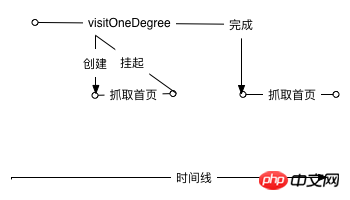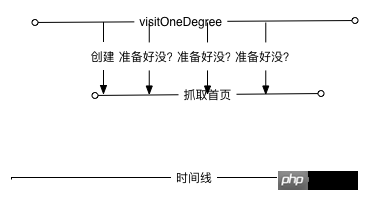用Swoole异步抓取网页实战分享
php程序员都知道,使用php写的程序都是同步的,如何用php写一个异步程序呢,答案就是Swoole。这里以抓取网页内容为例,来展示如何用Swoole来编写异步程序。
php的同步程序
在写异步程序之前,不要着急,先用php实现一下同步的程序。
<?php
/**
* Class Crawler
* Path: /Sync/Crawler.php
*/
class Crawler
{
private $url;
private $toVisit = [];
public function __construct($url)
{
$this->url = $url;
}
public function visitOneDegree()
{
$this->loadPageUrls();
$this->visitAll();
}
private function loadPageUrls()
{
$content = $this->visit($this->url);
$pattern = '#((http|ftp)://(\S*?\.\S*?))([\s)\[\]{},;"\':<]|\.\s|$)#i';
preg_match_all($pattern, $content, $matched);
foreach ($matched[0] as $url) {
if (in_array($url, $this->toVisit)) {
continue;
}
$this->toVisit[] = $url;
}
}
private function visitAll()
{
foreach ($this->toVisit as $url) {
$this->visit($url);
}
}
private function visit($url)
{
return @file_get_contents($url);
}
}<?php /** * crawler.php */ require_once 'Sync/Crawler.php'; $start = microtime(true); $url = 'http://www.swoole.com/'; $ins = new Crawler($url); $ins->visitOneDegree(); $timeUsed = microtime(true) - $start; echo "time used: " . $timeUsed; /* output: time used: 6.2610177993774 */
Swoole实现异步爬虫初探
先参考一下官方的异步抓取页面怎么搞。
使用示例
Swoole\Async::dnsLookup("www.baidu.com", function ($domainName, $ip) {
$cli = new swoole_http_client($ip, 80);
$cli->setHeaders([
'Host' => $domainName,
"User-Agent" => 'Chrome/49.0.2587.3',
'Accept' => 'text/html,application/xhtml+xml,application/xml',
'Accept-Encoding' => 'gzip',
]);
$cli->get('/index.html', function ($cli) {
echo "Length: " . strlen($cli->body) . "\n";
echo $cli->body;
});
});貌似稍微改造一下同步的file_get_contents代码,就可以实现异步了,看起来成功轻而易举嘛。
于是,我们得到了下面的代码:
<?php
/**
* Class Crawler
* Path: /Async/CrawlerV1.php
*/
class Crawler
{
private $url;
private $toVisit = [];
private $loaded = false;
public function __construct($url)
{
$this->url = $url;
}
public function visitOneDegree()
{
$this->visit($this->url, true);
$retryCount = 3;
do {
sleep(1);
$retryCount--;
} while ($retryCount > 0 && $this->loaded == false);
$this->visitAll();
}
private function loadPage($content)
{
$pattern = '#((http|ftp)://(\S*?\.\S*?))([\s)\[\]{},;"\':<]|\.\s|$)#i';
preg_match_all($pattern, $content, $matched);
foreach ($matched[0] as $url) {
if (in_array($url, $this->toVisit)) {
continue;
}
$this->toVisit[] = $url;
}
}
private function visitAll()
{
foreach ($this->toVisit as $url) {
$this->visit($url);
}
}
private function visit($url, $root = false)
{
$urlInfo = parse_url($url);
Swoole\Async::dnsLookup($urlInfo['host'], function ($domainName, $ip) use($urlInfo, $root) {
$cli = new swoole_http_client($ip, 80);
$cli->setHeaders([
'Host' => $domainName,
"User-Agent" => 'Chrome/49.0.2587.3',
'Accept' => 'text/html,application/xhtml+xml,application/xml',
'Accept-Encoding' => 'gzip',
]);
$cli->get($urlInfo['path'], function ($cli) use ($root) {
if ($root) {
$this->loadPage($cli->body);
$this->loaded = true;
}
});
});
}
}<?php /** * crawler.php */ require_once 'Async/CrawlerV1.php'; $start = microtime(true); $url = 'http://www.swoole.com/'; $ins = new Crawler($url); $ins->visitOneDegree(); $timeUsed = microtime(true) - $start; echo "time used: " . $timeUsed; /* output: time used: 3.011773109436 */
结果运行了3秒。注意一下我的实现,在发起抓取首页的请求以后,我会隔一秒轮询一次结果,轮询三次还没有就结束了。这里的3秒好像是轮询了3次还没有结果导致的退出。
看来是我太急躁了,给人家的准备时间还不够充分。好吧,那我们把轮询次数改为10次,看看结果。
time used: 10.034232854843
此时我的心情,你懂的。
难道说是swoole的性能问题?为什么10秒还没有结果,难道是我的姿势不对?马克思老人家说过:“实践是检验真理的唯一标准”。看来需要debug一下才知道原因了。
于是,我在
$this->visitAll();
和
$this->loadPage($cli->body);
两处加了断点。最后发现总是先执行到visitAll(),再去执行loadPage()。
想了一下,大概明白原因了。到底是什么原因呢?
我期望的异步动态模型是这样的:

然而真实的场景不是这样的。通过调试,我大致了解到实际的模型应该是这样的:

也就是说,无论我怎么提高重试次数,数据永远不会准备好,数据只有在当前函数准备好以后,才会开始执行,这里的异步,只是减少了准备连接的时间。
那么问题来了,我该如何让程序在准备数据之后执行我期望的功能呢。
先看一下Swoole官方执行异步任务的代码是如何写的
$serv = new swoole_server("127.0.0.1", 9501);
//设置异步任务的工作进程数量
$serv->set(array('task_worker_num' => 4));
$serv->on('receive', function($serv, $fd, $from_id, $data) {
//投递异步任务
$task_id = $serv->task($data);
echo "Dispath AsyncTask: id=$task_id\n";
});
//处理异步任务
$serv->on('task', function ($serv, $task_id, $from_id, $data) {
echo "New AsyncTask[id=$task_id]".PHP_EOL;
//返回任务执行的结果
$serv->finish("$data -> OK");
});
//处理异步任务的结果
$serv->on('finish', function ($serv, $task_id, $data) {
echo "AsyncTask[$task_id] Finish: $data".PHP_EOL;
});
$serv->start();可以看到,官方是通过一个function匿名函数,将后续的执行逻辑传了进去。这么看,事情就变得简单多了。
url = $url;
}
public function visitOneDegree()
{
$this->visit($this->url, function ($content) {
$this->loadPage($content);
$this->visitAll();
});
}
private function loadPage($content)
{
$pattern = '#((http|ftp)://(\S*?\.\S*?))([\s)\[\]{},;"\':<]|\.\s|$)#i';
preg_match_all($pattern, $content, $matched);
foreach ($matched[0] as $url) {
if (in_array($url, $this->toVisit)) {
continue;
}
$this->toVisit[] = $url;
}
}
private function visitAll()
{
foreach ($this->toVisit as $url) {
$this->visit($url);
}
}
private function visit($url, $callBack = null)
{
$urlInfo = parse_url($url);
Swoole\Async::dnsLookup($urlInfo['host'], function ($domainName, $ip) use($urlInfo, $callBack) {
if (!$ip) {
return;
}
$cli = new swoole_http_client($ip, 80);
$cli->setHeaders([
'Host' => $domainName,
"User-Agent" => 'Chrome/49.0.2587.3',
'Accept' => 'text/html,application/xhtml+xml,application/xml',
'Accept-Encoding' => 'gzip',
]);
$cli->get($urlInfo['path'], function ($cli) use ($callBack) {
if ($callBack) {
call_user_func($callBack, $cli->body);
}
$cli->close();
});
});
}
}看了这段代码,竟然有种似曾相识的感觉,在nodejs开发中,随处可见的callback原来是有它的道理的。现在我才突然明白,原来callback的存在就是为了解决异步问题的。
执行了一下程序,竟然只用0.0007s,还没开始就已经结束了!异步的效率真的能提升这么多吗?答案当然是否定的,是我们的代码出问题了。
由于用了异步,没有等任务完全跑完,就已经执行了计算结束的时间的逻辑。看来又到了用callback的时候了。
/**
Async/Crawler.php
**/
public function visitOneDegree($callBack)
{
$this->visit($this->url, function ($content) use($callBack) {
$this->loadPage($content);
$this->visitAll();
call_user_func($callBack);
});
}<?php
/**
* crawler.php
*/
require_once 'Async/Crawler.php';
$start = microtime(true);
$url = 'http://www.swoole.com/';
$ins = new Crawler($url);
$ins->visitOneDegree(function () use($start) {
$timeUsed = microtime(true) - $start;
echo "time used: " . $timeUsed;
});
/*output:
time used: 0.068463802337646
*/现在来看,结果可信多了。
让我们比较一下同步的异步的差距,同步耗时6.26s,异步耗时0.068秒,差了整整6.192s。不,更准确地表述,应该是差了将近10倍!
当然,从效率上讲,异步远远高于同步的代码,但是从逻辑上讲,异步的逻辑比同步更绕,代码中会带来大量的callback,不便于理解。
Swoole官方里有一段关于异步与同步的选择的描述,非常中肯,分享给大家:
我们不赞成用异步回调的方式去做功能开发,传统的PHP同步方式实现功能和逻辑是最简单的,也是最佳的方案。像node.js这样到处callback,只是牺牲可维护性和开发效率。
相关阅读:
以上就是本篇文章的所有内容,同学们如果有疑问可以在下方评论区讨论哦~
以上是用Swoole异步抓取网页实战分享的详细内容。更多信息请关注PHP中文网其他相关文章!

热AI工具

Undresser.AI Undress
人工智能驱动的应用程序,用于创建逼真的裸体照片

AI Clothes Remover
用于从照片中去除衣服的在线人工智能工具。

Undress AI Tool
免费脱衣服图片

Clothoff.io
AI脱衣机

AI Hentai Generator
免费生成ai无尽的。

热门文章

热工具

记事本++7.3.1
好用且免费的代码编辑器

SublimeText3汉化版
中文版,非常好用

禅工作室 13.0.1
功能强大的PHP集成开发环境

Dreamweaver CS6
视觉化网页开发工具

SublimeText3 Mac版
神级代码编辑软件(SublimeText3)

热门话题
 swoole协程如何在laravel中使用
Apr 09, 2024 pm 06:48 PM
swoole协程如何在laravel中使用
Apr 09, 2024 pm 06:48 PM
Laravel 中使用 Swoole 协程可以并发处理大量请求,优势包括:并发处理:允许同时处理多个请求。高性能:基于 Linux epoll 事件机制,高效处理请求。低资源消耗:所需服务器资源更少。易于集成:与 Laravel 框架无缝集成,使用简单。
 swoole和workerman哪个好
Apr 09, 2024 pm 07:00 PM
swoole和workerman哪个好
Apr 09, 2024 pm 07:00 PM
Swoole 和 Workerman 都是高性能 PHP 服务器框架。Swoole 以其异步处理、出色的性能和可扩展性而闻名,适用于需要处理大量并发请求和高吞吐量的项目。Workerman 提供了异步和同步模式的灵活性,具有直观的 API,更适合易用性和处理较低并发量的项目。
 swoole框架怎么重启服务
Apr 09, 2024 pm 06:15 PM
swoole框架怎么重启服务
Apr 09, 2024 pm 06:15 PM
要重启 Swoole 服务,请按照以下步骤操作:检查服务状态并获取 PID。使用 "kill -15 PID" 停止服务。使用启动服务的相同命令重新启动服务。
 swoole和java哪个性能好
Apr 09, 2024 pm 07:03 PM
swoole和java哪个性能好
Apr 09, 2024 pm 07:03 PM
性能比较:吞吐量:Swoole 凭借协程机制,吞吐量更高。延迟:Swoole 的协程上下文切换开销更低,延迟更小。内存消耗:Swoole 的协程占用内存更少。易用性:Swoole 提供更易于使用的并发编程 API。
 Swoole实战:如何使用协程进行并发任务处理
Nov 07, 2023 pm 02:55 PM
Swoole实战:如何使用协程进行并发任务处理
Nov 07, 2023 pm 02:55 PM
Swoole实战:如何使用协程进行并发任务处理引言在日常的开发中,我们常常会遇到需要同时处理多个任务的情况。传统的处理方式是使用多线程或多进程来实现并发处理,但这种方式在性能和资源消耗上存在一定的问题。而PHP作为一门脚本语言,通常无法直接使用多线程或多进程的方式来处理任务。然而,借助于Swoole协程库,我们可以使用协程来实现高性能的并发任务处理。本文将介
 Swoole进阶:如何优化服务器的CPU利用率
Nov 07, 2023 pm 12:27 PM
Swoole进阶:如何优化服务器的CPU利用率
Nov 07, 2023 pm 12:27 PM
Swoole是一款高性能的PHP网络开发框架,借助其强大的异步机制和事件驱动特点,可以实现快速构建高并发、高吞吐的服务器应用。然而,随着业务的不断扩展和并发量的增加,服务器的CPU利用率可能会成为一个瓶颈,影响服务器的性能和稳定性。因此,在本文中,我们将介绍如何优化服务器的CPU利用率,同时提高Swoole服务器的性能和稳定性,并提供具体的优化代码示例。一、
 swoole协程是怎样调度的
Apr 09, 2024 pm 07:06 PM
swoole协程是怎样调度的
Apr 09, 2024 pm 07:06 PM
Swoole协程是一种轻量级并发库,允许开发者编写并发程序。Swoole协程调度机制基于协程模式和事件循环,使用协程栈管理协程执行,在协程让出控制权后挂起它们。事件循环处理IO和定时器事件,协程让出控制权时被挂起并返回事件循环。当事件发生时,Swoole从事件循环切换到挂起的协程,通过保存和加载协程状态完成切换。协程调度使用优先级机制,支持挂起、休眠和恢复操作以灵活控制协程执行。







